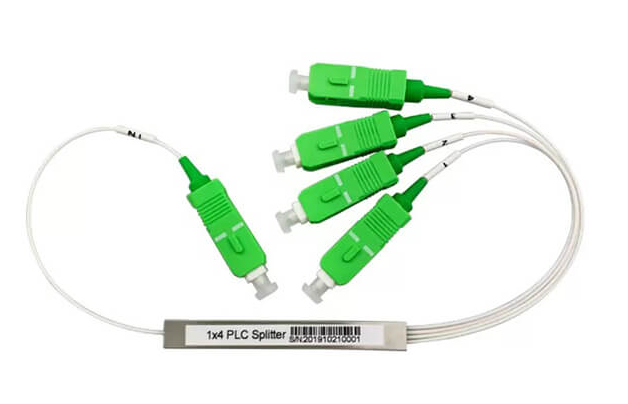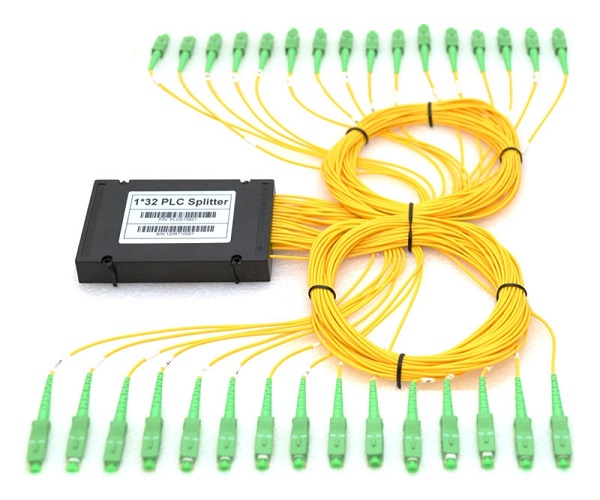Like the coaxial cable transmission system, the optical network system also needs to couple, branch, and distribute optical signals, which requires an optical splitter to achieve. PLC splitter is also called planar optical waveguide splitter, which is a kind of optical splitter.
1. Brief introduction of PLC optical splitter
2. The structure of fiber PLC splitter
3. The production technology of optical PLC splitter
4. Performance parameter table of PLC splitter
5. Classification of PLC optical splitter
6. Features of fiber PLC splitter
7. Advantages of optical PLC splitter
8. Disadvantages of PLC splitter
9. Fiber PLC splitter application
1. Brief introduction of PLC optical splitter
The PLC splitter is an integrated waveguide optical power distribution device based on a quartz substrate. It consists of pigtails, core chips, optical fiber arrays, shells (ABS boxes, steel pipes), connectors and optical cables, etc. Based on planar optical waveguide technology, the optical input is converted into multiple optical outputs evenly through a precise coupling process.

Planar waveguide type optical splitter (PLC splitter) has the characteristics of small size, wide working wavelength range, high reliability, and good optical splitting uniformity. It is especially suitable for connecting central office in passive optical networks (EPON, BPON, GPON, etc.) and the terminal equipment and realize the branch of the optical signal. There are currently two types: 1xN and 2xN. 1×N and 2XN splitters uniformly input optical signals from single or double inlets to multiple outlets, or work in reverse to converge multiple optical signals into single or double optical fibers.
2. The structure of fiber PLC splitter
The optical PLC splitter is one of the most important passive components in the optical fiber link. It plays an important role in the FTTH passive optical network. It is an optical fiber tandem device with multiple input ends and multiple output ends. Its three most important components are the input end, output end and chip of the optical fiber array. The design and assembly of these three components play a vital role in whether the PLC optical splitter can work stably and normally afterwards.
1) Input/output structure
The input/output structure includes a cover plate, a substrate, an optical fiber, a soft glue area, and a hard glue area.
Soft glue area: Used to fix the optical fiber to the cover and bottom of the FA, while protecting the optical fiber from damage.
Hard glue area: Fix the FA cover, bottom plate and optical fiber in the V-groove.
2) SPL chip
The SPL chip consists of a chip and a cover plate. According to the number of input and output channels, it is usually divided into 1×8, 1×16, 2×8, etc. According to the angle, it is usually divided into +8° and -8° chips.

3. The production technology of optical PLC splitter
The PLC splitter is made by semiconductor technology (lithography, etching, development, etc.). The optical waveguide array is located on the upper surface of the chip, and the shunt function is integrated on the chip. That is to realize 1:1 equal splitting on a chip. Then, the input end and the output end of the multi-channel optical fiber array are respectively coupled at both ends of the chip and packaged.
4. Performance parameter table of PLC splitter
1) 1xN PLC Splitter
| Parameter | 1×2 | 1×4 | 1×8 | 1×16 | 1×32 | 1×64 | |
| Fiber type | SMF-28e | ||||||
| Working wavelength(nm) | 1260~1650 | ||||||
| Insertion loss(dB) | Typical value | 3.7 | 6.8 | 10.0 | 13.0 | 16.0 | 19.5 |
| Max | 4.0 | 7.2 | 10.5 | 13.5 | 16.9 | 21.0 | |
| Loss uniformity(dB) | Max | 0.4 | 0.6 | 0.8 | 1.2 | 1.5 | 2.5 |
| Return loss(dB) | Min | 50 | 50 | 50 | 50 | 50 | 50 |
| Polarization dependent loss(dB) | Max | 0.2 | 0.2 | 0.3 | 0.3 | 0.3 | 0.4 |
| Directionality(dB) | Min | 55 | 55 | 55 | 55 | 55 | 55 |
| Wavelength dependent loss(dB) | Max | 0.3 | 0.3 | 0.3 | 0.5 | 0.5 | 0.8 |
| Temperature dependent loss(-40~+85℃) | Max | 0.5 | 0.5 | 0.5 | 0.8 | 0.8 | 1.0 |
| Operating temperature(℃) | -40~+85 | ||||||
| Storage temperature(℃) | -40~+85 | ||||||
2) 2xN PLC Splitter
| Parameter | 2×2 | 2×4 | 2×8 | 2×16 | 2×32 | 2×64 | |
| Fiber type | SMF-28e | ||||||
| Working wavelength(nm) | 1260~1650 | ||||||
| Insertion loss(dB) | Typical value | 3.8 | 7.4 | 10.8 | 14.2 | 17.0 | 21.0 |
| Max | 4.2 | 7.8 | 11.2 | 14.6 | 17.5 | 21.5 | |
| Loss uniformity(dB) | Max | 1.0 | 1.4 | 1.5 | 2.0 | 2.5 | 2.5 |
| Return loss(dB) | Min | 50 | 50 | 50 | 50 | 50 | 50 |
| Polarization dependent loss(dB) | Max | 0.2 | 0.2 | 0.4 | 0.4 | 0.4 | 0.5 |
| Directionality(dB) | Min | 55 | 55 | 55 | 55 | 55 | 55 |
| Wavelength dependent loss(dB) | Max | 0.8 | 0.8 | 0.8 | 0.8 | 0.8 | 1.0 |
| Temperature dependent loss(-40~+85℃) | Max | 0.5 | 0.5 | 0.5 | 0.8 | 0.8 | 1.0 |
| Operating temperature(℃) | -40~+85 | ||||||
| Storage temperature(℃) | -40~+85 | ||||||
5. Classification of PLC optical splitter
There are many commonly used PLC optical splitters, such as: bare fiber PLC optical splitter, micro steel pipe splitter, ABS box optical splitter, splitter type optical splitter, tray type optical splitter Splitter, rack-mounted optical splitter LGX optical splitter and micro plug-in PLC optical splitter.
6. Features of fiber PLC splitter
- Wide working wavelength
- Low insertion loss
- Low polarization dependent loss
- Miniaturized design
- Good consistency between channels
- High reliability and stability-Pass GR-1221-CORE reliability test 7 Pass GR-12091-CORE reliability test
- RoHS compliant
- Different types of connectors can be provided according to customer needs, with quick installation and reliable performance.
7. Advantages of optical PLC splitter
(1) Loss is not sensitive to light wavelength and can meet the transmission needs of different wavelengths.
(2) The light is evenly split, and the signal can be evenly distributed to users.
(3) Compact structure, small volume, can be directly installed in various existing transfer boxes, no special design is required to leave a lot of installation space.
(4) There are many shunt channels for a single device, which can reach more than 64 channels.
(5) The multi-channel cost is low, and the more the number of branches, the more obvious the cost advantage.

8. Disadvantages of PLC splitter
(1) The device manufacturing process is complex and the technical threshold is high. At present, the chip is monopolized by several foreign companies, and there are only a few domestic companies capable of mass packaging production.
(2) The cost is higher than that of the fusion taper splitter. Especially in the low-channel splitter, it is at a disadvantage.
9. Fiber PLC splitter application
1) Rack-mounted optical splitter
① Installed in a 19-inch OLT cabinet;
② When the fiber branch enters the home, the installation equipment provided is a standard digital cabinet;
③ When the ODN needs to be placed on the table.
① Installed in a 19-inch standard rack;
② When the fiber branch enters the home, the installation equipment provided is the fiber optic cable transfer box;
③ Install in the equipment designated by the customer when the fiber branch enters the home.3) Bare fiber PLC optical splitter
① Installed in various types of pigtail boxes.
②Installed in various types of test instruments and WDM systems.4) Optical splitter with splitter
① Installed in various types of optical distribution equipment.
②Installed in various types of optical test instruments.

5) Miniature steel pipe splitter
① Installed in the optical cable connector box.
②Install in the module box.
③Install in the wiring box.
6) Miniature plug-in PLC optical splitter
This device is an access point for users who need to split light in the FTTX system. It mainly completes the end of the optical cable entering the residential area or building, and has the functions of fixing, stripping, fusion splicing, patching, and branching of the optical fiber. After the light is split, it enters the end user in the form of a home fiber optic cable.
7) Tray type optical splitter
It is suitable for integrated installation and use of various types of optical fiber splitters and wavelength division multiplexers.
Note: The single-layer tray is configured with 1 point and 16 adapter interfaces, and the double-layer tray is configured with 1 point and 32 adapter interfaces.
DOWELL is China famous PLC splitter manufacturer, providing high-quality and various fiber PLC splitter. Our company adopts high-quality PLC core, advanced independent production and manufacturing technology and good quality assurance, to continuously provide domestic and foreign users with high-quality optical performance, stability and reliability of PLC planar optical waveguide products. Micro-integrated packaging design and packaging meet the needs of various applications.
Post time: Mar-04-2023
